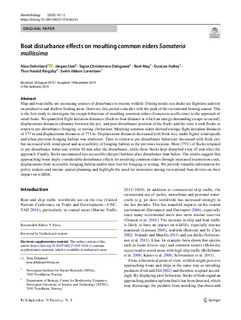Boat disturbance effects on moulting common eiders Somateria mollissima
Dehnhard, Nina; Skei, Jørgen; Christensen-Dalsgaard, Signe; May, Roelof Frans; Halley, Duncan John; Ringsby, Thor Harald; Lorentsen, Svein Håkon
Peer reviewed, Journal article
Published version

Åpne
Permanent lenke
http://hdl.handle.net/11250/2635086Utgivelsesdato
2020Metadata
Vis full innførselSamlinger
- Scientific publications [1423]
Originalversjon
10.1007/s00227-019-3624-zSammendrag
Ship and boat traffic are increasing sources of disturbance to marine wildlife. During moult, sea ducks are flightless and rely on productive and shallow feeding areas. However, this period coincides with the peak of the recreational boating season. This is the first study to investigate the escape behaviour of moulting common eiders (Somateria mollissima) to the approach of small boats. We quantified flight initiation distances (flock-to-boat distance at which an energy-demanding escape occurred),
displacement distances (distance between the pre- and post-disturbance position of the flock) and the time it took flocks to return to pre-disturbance (foraging- or resting-) behaviour. Moulting common eiders showed average flight initiation distances of 177 m and displacement distances of 771 m. Displacement distances decreased with flock size, under higher wind speeds and when previous foraging habitat was shallower. Time-to-return to pre-disturbance behaviour decreased with flock size
but increased with wind speed and accessibility of foraging habitat at the previous location. Most (75%) of flocks returned to pre-disturbance behaviour within 10 min after the disturbance, while three flocks kept disturbed even 45 min after the approach. Finally, flocks encountered less accessible (deeper) habitats after disturbance than before. Our results suggest that approaching boats imply considerable disturbance effects for moulting common eiders through increased locomotion costs, displacement from accessible foraging habitat and/or time lost for foraging or resting. We provide valuable information for policy makers and marine spatial planning and highlight the need for awareness among recreational boat drivers on their
impact on wildlife.
